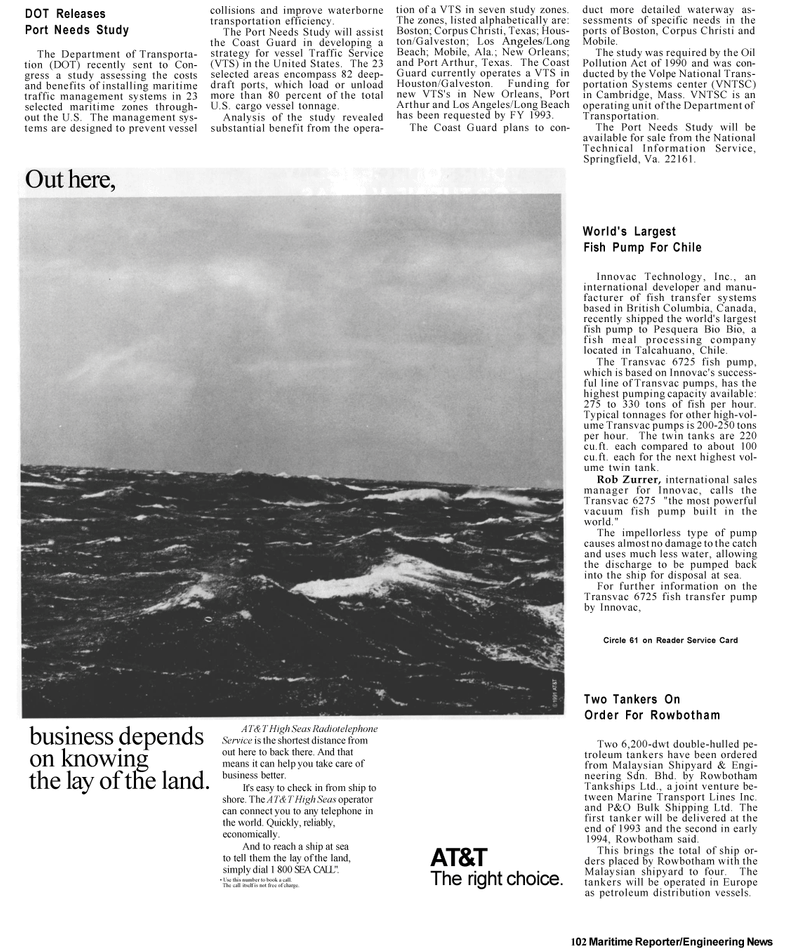
Page 61: of Maritime Reporter Magazine (April 1992)
Read this page in Pdf, Flash or Html5 edition of April 1992 Maritime Reporter Magazine
DOT Releases
Port Needs Study
The Department of Transporta- tion (DOT) recently sent to Con- gress a study assessing the costs and benefits of installing maritime traffic management systems in 23 selected maritime zones through- out the U.S. The management sys- tems are designed to prevent vessel collisions and improve waterborne transportation efficiency.
The Port Needs Study will assist the Coast Guard in developing a strategy for vessel Traffic Service (VTS) in the United States. The 23 selected areas encompass 82 deep- draft ports, which load or unload more than 80 percent of the total
U.S. cargo vessel tonnage.
Analysis of the study revealed substantial benefit from the opera- tion of a VTS in seven study zones.
The zones, listed alphabetically are:
Boston; Corpus Christi, Texas; Hous- ton/Galveston; Los Angeles/Long
Beach; Mobile, Ala.; New Orleans; and Port Arthur, Texas. The Coast
Guard currently operates a VTS in
Houston/Galveston. Funding for new VTS's in New Orleans, Port
Arthur and Los Angeles/Long Beach has been requested by FY 1993.
The Coast Guard plans to con- duct more detailed waterway as- sessments of specific needs in the ports of Boston, Corpus Christi and
Mobile.
The study was required by the Oil
Pollution Act of 1990 and was con- ducted by the Volpe National Trans- portation Systems center (VNTSC) in Cambridge, Mass. VNTSC is an operating unit of the Department of
Transportation.
The Port Needs Study will be available for sale from the National
Technical Information Service,
Springfield, Va. 22161.
World's Largest
Fish Pump For Chile
Innovac Technology, Inc., an international developer and manu- facturer of fish transfer systems based in British Columbia, Canada, recently shipped the world's largest fish pump to Pesquera Bio Bio, a fish meal processing company located in Talcahuano, Chile.
The Transvac 6725 fish pump, which is based on Innovac's success- ful line of Transvac pumps, has the highest pumping capacity available: 275 to 330 tons of fish per hour.
Typical tonnages for other high-vol- ume Transvac pumps is 200-250 tons per hour. The twin tanks are 220 cu.ft. each compared to about 100 cu.ft. each for the next highest vol- ume twin tank.
Rob Zurrer, international sales manager for Innovac, calls the
Transvac 6275 "the most powerful vacuum fish pump built in the world."
The impellorless type of pump causes almost no damage to the catch and uses much less water, allowing the discharge to be pumped back into the ship for disposal at sea.
For further information on the
Transvac 6725 fish transfer pump by Innovac,
Circle 61 on Reader Service Card business depends on knowing the lay of the land.
AT&T High Seas Radiotelephone
Service is the shortest distance from out here to back there. And that means it can help you take care of business better.
It's easy to check in from ship to shore. The AT&T High Seas operator can connect you to any telephone in the world. Quickly, reliably, economically.
And to reach a ship at sea to tell them the lay of the land, simply dial 1 800 SEA CALL". • Use this number to book a call.
The call itself is not free of charge.
AT&T
The right choice.
Two Tankers On
Order For Rowbotham
Two 6,200-dwt double-hulled pe- troleum tankers have been ordered from Malaysian Shipyard & Engi- neering Sdn. Bhd. by Rowbotham
Tankships Ltd., a joint venture be- tween Marine Transport Lines Inc. and P&O Bulk Shipping Ltd. The first tanker will be delivered at the end of 1993 and the second in early 1994, Rowbotham said.
This brings the total of ship or- ders placed by Rowbotham with the
Malaysian shipyard to four. The tankers will be operated in Europe as petroleum distribution vessels.
Out here, 102 Maritime Reporter/Engineering News

 60
60

 62
62
